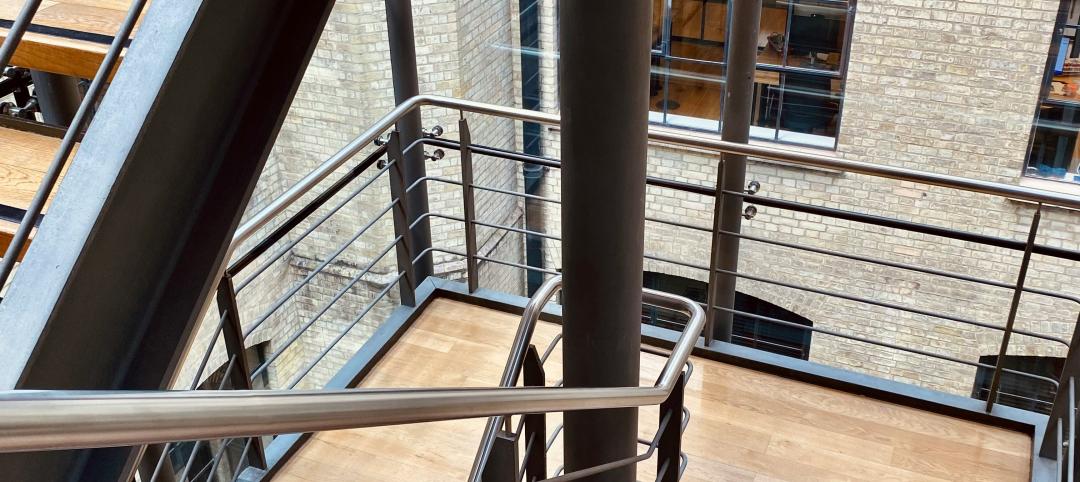For years, the steel joist industry standard has been that loads either need to be applied at panel points, or a member brace (strut) must be added in the field. In response to inquiries from structural engineers and other members of the Building Team, the Steel Joist Institute recently issued a new rule for loads not exceeding 100 pounds within any given panel.
The full text of the SJI rule reads as follows: “For nominal concentrated loads between panel points, which have been accounted for in the specified uniform design loads, a strut to transfer the load to a panel point on the opposite chord shall not be required, provided the sum of the concentrated loads within a chord panel does not exceed 100 pounds and the attachments are concentric to the chord.”
Bruce Brothersen, engineering manager for Vulcraft-Utah, Brigham, Utah, says, “The rule is an attempt to better define what is acceptable and put some quantitative numbers to it.”
Tim Holtermann, corporate engineering manager for Canam Steel in Washington, Mo., says that even with the new rule, manufacturers remain concerned that “people may be hanging things in excess of 100 pounds away from panel points and not field-adding struts, as they’re required to do.”
Holtermann says one option for structural engineers is to ask the manufacturer to provide a specially designed joist that can take point loads over 100 pounds without the added members. “It’s not uncommon to have a design requirement for, say, 250 pounds or 400 pounds,” he says. “We can readily do that as long as the magnitude of the loads and this design requirement are specified on the contract drawings.”
DON’T WAIT FOR THE FINAL PUNCH LIST
Often the problem with the joist loads isn’t discovered until the project is completed and the final walkthrough is taking place, says Joe Pote, director of research and development for New Millennium Building Systems, Hope, Ark.
“The inspector notices ductwork or sprinkler lines or mechanicals hanging from the joists between panel points that aren’t called out on the contract drawings,” says Pote. “Then he comes back to us and asks if it’s okay.” Many times the loads are small (20-50 pounds), so additional reinforcement isn’t necessary. “But we never had a good rule that stated the maximum load,” he says. “I think it helps clear up some of the discrepancy between SJI requirements and actual field practice.”
The manner in which the loads are hung is a key element of the 100-pound rule, says Holtermann. “The rule presumes that the load will be placed concentrically,” he says.
As SJI managing director Ken Charles notes, some trade installers make the mistake of attaching beam clamps to only one bottom chord angle of the joist instead of both. On top of that, he says, “the load isn’t placed concentrically even to that one chord angle, so you’re inducing some torsion and bending of the horizontal leg of the angle.”
His advice: “By far the better way to do it is to make sure the attachment is always concentric and always attached to both chord angles.” (See diagram.)
Steel Joist Do’s and Don’ts
- Recognize how and when to specify total uniform load or factored load and/or net uplift load, and when loads need to be broken out by load category and combinations.
- Know the limits of a concentrated load applied between panel points before an additional web is needed on the joist. The Steel Joist Institute’s new “100-pound rule” clarifies these limits.
- Install bridging early and follow the proper procedures to avoid safety problems, such as a partial building collapse.
- Designate a field representative to inspect the joists during construction and ensure that components are being installed correctly.Ideally, a representative of the team should walk the job site before completion and look for situations where loads aren’t handled correctly.
“A lot of times there’s a disconnect between the design intent and the construction site personnel,” says Charles. “Some sites have representatives in the field to do inspections, but often that’s not the case. Those are the projects that are most likely to have problems down the road when the final punch list is done.”
GET YOUR SPECS STRAIGHT
Joists are designed to handle different types of loads, such as dead load, live load, and wind, snow, and seismic loads. A given joist might experience more than one type of load, so the joist manufacturer needs to know which loads apply and properly combine them according to parameters set by the International Building Code. Most jurisdictions use the 2006 version of the IBC or the 2009 version, which is similar with regard to steel joists.
Brothersen notes that the building code loading combinations are based on the probability of which loads will act simultaneously. “For instance, the probability of a seismic event occurring when the maximum snow load is on the joist is relatively small, so the building code reduces the loads in those cases,” he says. “This is more realistic and doesn’t require manufacturers to design for the maximum load in every category at the same time.”
Pote says manufacturers prefer, when it’s feasible, that loads be provided to them as either a total uniform load or a factored load. In other words, if all components of the joist can be designed for a single downward-acting load case and a single upward-acting load case, the easiest thing for engineers to do is provide the total uniform load and/or net uplift load (dead load minus wind load).
“It’s just easier to communicate,” says Charles. “However, if we have to consider multiple load combinations, we need the breakdown—dead load, live load, snow load, and so forth.”
Holtermann adds that if the structure might be affected by downward-acting winds, the total uniform load should assume the worst-case scenario.
DON’T FORGET THE BRIDGING
Once the joists arrive on site, it’s important that bridging be installed early and correctly, says Brothersen. “If the joists are put up but the bridging isn’t installed, it can become a safety issue.” For example, lack of bridging can result in a partial building collapse when the crew begins stacking bundles of deck material on the joists.
Charles agrees. “The best-laid plans of the engineer and manufacturer can go out the window when the product arrives at the job site and the erector doesn’t follow proper safety regulations and the manufacturer’s advice.” BD+C
--
Editor’s note: To order SJI’s “43rd Edition Catalog of Standard Specifications and Load and Weight Tables for Steel Joists and Joist Girders,” go to: http://steeljoist.org/free-download-form.
Related Stories
K-12 Schools | Aug 29, 2024
Designing for dyslexia: How architecture can address neurodiversity in K-12 schools
Architects play a critical role in designing school environments that support students with learning differences, particularly dyslexia, by enhancing social and emotional competence and physical comfort. Effective design principles not only benefit students with dyslexia but also improve the learning experience for all students and faculty. This article explores how key design strategies at the campus, classroom, and individual levels can foster confidence, comfort, and resilience, thereby optimizing educational outcomes for students with dyslexia and other learning differences.
Museums | Aug 29, 2024
Bjarke Ingels' Suzhou Museum of Contemporary Art conceived as village of 12 pavilions
The 60,000-sm Suzhou Museum of Contemporary Art in Suzhou, Jiangsu, China recently topped out. Designed by Bjarke Ingels Group (BIG), the museum is conceived as a village of 12 pavilions, offering a modern interpretation of the elements that have defined the city’s urbanism, architecture, and landscape for centuries.
Adaptive Reuse | Aug 28, 2024
Cities in Washington State will offer tax breaks for office-to-residential conversions
A law passed earlier this year by the Washington State Legislature allows developers to defer sales and use taxes if they convert existing structures, including office buildings, into affordable housing.
Industrial Facilities | Aug 28, 2024
UK-based tire company plans to build the first carbon-neutral tire factory in the U.S.
ENSO, a U.K.-based company that makes tires for electric vehicles, has announced plans to build the first carbon-neutral tire factory in the U.S. The $500 million ENSO technology campus will be powered entirely by renewable energy. The first-of-its-kind tire factory aims to be carbon neutral without purchased offsets, using carbon-neutral raw materials and building materials.
Architects | Aug 28, 2024
KTGY acquires residential high-rise specialist GDA Architects
KTGY, an award-winning design firm focused on architecture, interior design, branded environments and urban design, announced that it has acquired GDA Architects, a Dallas-based architectural firm specializing in high rise residential, hospitality and industrial design.
K-12 Schools | Aug 26, 2024
Windows in K-12 classrooms provide opportunities, not distractions
On a knee-jerk level, a window seems like a built-in distraction, guaranteed to promote wandering minds in any classroom or workspace. Yet, a steady stream of studies has found the opposite to be true.
Building Technology | Aug 23, 2024
Top-down construction: Streamlining the building process | BD+C
Learn why top-down construction is becoming popular again for urban projects and how it can benefit your construction process in this comprehensive blog.
Airports | Aug 22, 2024
Portland opens $2 billion mass timber expansion and renovation to its international airport
This month, the Portland International Airport (PDX) main terminal expansion opened to passengers. Designed by ZGF for the Port of Portland, the 1 million-sf project doubles the capacity of PDX and enables the airport to welcome 35 million passengers per year by 2045.
Adaptive Reuse | Aug 22, 2024
6 key fire and life safety considerations for office-to-residential conversions
Office-to-residential conversions may be fraught with fire and life safety challenges, from egress requirements to fire protection system gaps. Here are six important considerations to consider.
Resiliency | Aug 22, 2024
Austin area evacuation center will double as events venue
A new 45,000 sf FEMA-operated evacuation shelter in the Greater Austin metropolitan area will begin construction this fall. The center will be available to house people in the event of a disaster such as a major hurricane and double as an events venue when not needed for emergency shelter.

















